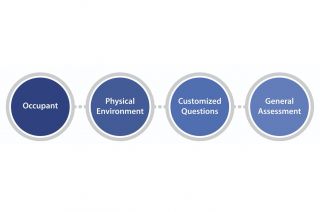
www.buildingsandcities.org/insights/news/urban-density-covid.html
Is Urban Density a Key Factor in the Spread of Covid-19?

A new peer-reviewed paper examines the literature on the influence of urban density on the diffusion of Covid-19.
Public discussion of Covid-19 has often tried to make a
connection between urban density and the rate of virus diffusion. The primary
assertion is that more densely populated areas have experienced a faster spread
of Covid-19. In Jacques Teller's recent Buildings & Cities synthesis paper, URBAN DENSITY AND COVID-19: TOWARDS AN ADAPTIVE APPROACH, he compares research studies to consider whether this is actually the case.
There is no scientific consensus about urban density's role in the spread of
Covid-19. Instead, urban connectivity (the movement of people between cities)
is likely to play a bigger role in the diffusion of the pandemic.
A total of 15 recent papers on the connection between urban density and Covid-19 are examined. Across these statistical studies, Teller finds the connection between urban density and the diffusion of Covid-19 is a complex and disputed issue. Teller highlights that all of the studies acknowledged the multifactorial nature of Covid-19 diffusion, and often incorporated several factors into their analysis. Six core factors were identified in the different papers:
- Urban settlement: This is comprised of urban density (number of inhabitants/km2), internal mobility (between urban, peri-urban and rural areas) and external connectivity (flows of people between cities)
- Socioeconomic characteristics: Mean age; life expectancy; personal economic circumstances; household composition; race and ethnicity.
- Urban services: For example, the presence of healthcare and hospitals.
- Urban environment: Air pollution; the concentration of particulate matter; air temperature and relative humidity.
- Non-pharmaceutical interventions adopted: Social distancing; face-covering and hand-sanitising; travel restrictions; stay-at-home measures; obligations to quarantine.
- Time: e.g. the delay between the start of the epidemic and the adoption of containment measures.
Of the six factors there was no single factor that clearly emerged as having a larger influence than others. Instead, the factors are closely intertwined in shaping the diffusion of the epidemic. In addition, each study only considered a sub-set of the factors listed. This divergence, along with several other differences made it difficult to compare and draw conclusions from the studies.
Crucially, the papers do not have a shared definition of urban density, nor do they all use the same dependent variable (this includes: total number of reported cases; number of reported cases/100,000 inhabitants; and number of reported deaths/ 100,000 inhabitants). Teller suggests that approaches to testing and tracing need to be incorporated into analyses, since differences in how cases and deaths were reported and counted will influence outcomes.
An important distinction between urban density and connectivity was not made across the papers. In studies that did distinguish between density and connectivity, the influence of urban density on the diffusion of Covid-19 tends to be reduced or negative. Only a small number of the studies considered external connectivity, even though it is widely acknowledged to play a crucial role in the diffusion of diseases in a globalised world. Teller notes that denser and larger cities are usually more connected; ignoring external connectivity may therefore lead to overestimations and an overemphasis of the role of urban density.
A number of gaps provide a valuable starting point for future enquiry. Teller suggests that:
- A more sophisticated approach to defining and analysing density is necessary: mean density is too aggregated 'to reveal the strength of connectivity and urban flows in the city'
- There is a need to address the unbounded and topological nature of the city
- Overcrowding and density may be better addressed at the building level, and related to residential or work activities
- Analysts must pay increased attention to construction techniques and building operation systems (see Edward Ng's commentary From SARS to COVID-19 and Beyond: Public Health Lessons for Buildings for more on this)
- Analysis needs to address divergence in governance styles and structures
- Studies are urgently needed to explore the role of urban density in economically developing countries, particularly in informal settlements.
It is only through synthesis of the type that Teller has undertaken here that we can see the patterns and gaps emerging in approaches to study this complex phenomenon. Through this, more conclusive analysis and clear ways forward for managing virus spread in urban environments can be developed.
Reference
Teller J. (2021). Urban density and Covid-19: towards an adaptive approach. Buildings and Cities, 2(1), pp. 150-165. DOI: https://doi.org/10.5334/bc.89
Latest Peer-Reviewed Journal Content
A framework for 1.5°C-aligned GHG budgets in architecture
G Betti, I Spaar, D Bachmann, A Jerosch-Herold, E Kühner, R Yang, K Avhad & S Sinning
Net zero retrofit of the building stock [editorial]
D Godoy-Shimizu & P Steadman
Co-learning in living labs: nurturing civic agency and resilience
A Belfield
The importance of multi-roles and code-switching in living labs
H Noller & A Tarik
Researchers’ shifting roles in living labs for knowledge co-production
C-C Dobre & G Faldi
Increasing civic resilience in urban living labs: city authorities’ roles
E Alatalo, M Laine & M Kyrönviita
Co-curation as civic practice in community engagement
Z Li, M Sunikka-Blank, R Purohit & F Samuel
Preserving buildings: emission reductions from circular economy strategies in Austria
N Alaux, V Kulmer, J Vogel & A Passer
Urban living labs: relationality between institutions and local circularity
P Palo, M Adelfio, J Lundin & E Brandão
Living labs: epistemic modelling, temporariness and land value
J Clossick, T Khonsari & U Steven
Co-creating interventions to prevent mosquito-borne disease transmission in hospitals
O Sloan Wood, E Lupenza, D M Agnello, J B Knudsen, M Msellem, K L Schiøler & F Saleh
Circularity at the neighbourhood scale: co-creative living lab lessons
J Honsa, A Versele, T Van de Kerckhove & C Piccardo
Positive energy districts and energy communities: how living labs create value
E Malakhatka, O Shafqat, A Sandoff & L Thuvander
Built environment governance and professionalism: the end of laissez-faire (again)
S Foxell
Co-creating justice in housing energy transitions through energy living labs
D Ricci, C Leiwakabessy, S van Wieringen, P de Koning & T Konstantinou
HVAC characterisation of existing Canadian buildings for decarbonisation retrofit identification
J Adebisi & J J McArthur
Simulation and the building performance gap [editorial]
M Donn
Developing criteria for effective building-sector commitments in nationally determined contributions
P Graham, K McFarlane & M Taheri
Reimagining circularity: actions for optimising the use of existing buildings
R Lundgren, R Kyrö, S Toivonen & L Tähtinen
Effective interdisciplinary stakeholder engagement in net zero building design
S Vakeva-Baird, F Tahmasebi, JJ Williams & D Mumovic
Metrics for building component disassembly potential: a practical framework
H Järvelä, A Lehto, T Pirilä & M Kuittinen
The unfitness of dwellings: why spatial and conceptual boundaries matter
E Nisonen, D Milián Bernal & S Pelsmakers
Environmental variables and air quality: implications for planning and public health
H Itzhak-Ben-Shalom, T Saroglou, V Multanen, A Vanunu, A Karnieli, D Katoshevski, N Davidovitch & I A Meir
Exploring diverse drivers behind hybrid heating solutions
S Kilpeläinen, S Pelsmakers, R Castaño-Rosa & M-S Miettinen
Urban rooms and the expanded ecology of urban living labs
E Akbil & C Butterworth
Living with extreme heat: perceptions and experiences
L King & C Demski
A systemic decision-making model for energy retrofits
C Schünemann, M Dshemuchadse & S Scherbaum
Modelling site-specific outdoor temperature for buildings in urban environments
K Cebrat, J Narożny, M Baborska-Narożny & M Smektała
Understanding shading through home-use experience, measurement and modelling
M Baborska-Narożny, K Bandurski, & M Grudzińska
Building performance simulation for sensemaking in architectural pedagogy
M Bohm
Beyond the building: governance challenges in social housing retrofit
H Charles
Heat stress in social housing districts: tree cover–built form interaction
C Lopez-Ordoñez, E Garcia-Nevado, H Coch & M Morganti
An observational analysis of shade-related pedestrian activity
M Levenson, D Pearlmutter & O Aleksandrowicz
Learning to sail a building: a people-first approach to retrofit
B Bordass, R Pender, K Steele & A Graham
Market transformations: gas conversion as a blueprint for net zero retrofit
A Gillich
Resistance against zero-emission neighbourhood infrastructuring: key lessons from Norway
T Berker & R Woods
Megatrends and weak signals shaping future real estate
S Toivonen
A strategic niche management framework to scale deep energy retrofits
T H King & M Jemtrud
Generative AI: reconfiguring supervision and doctoral research
P Boyd & D Harding
Exploring interactions between shading and view using visual difference prediction
S Wasilewski & M Andersen
How urban green infrastructure contributes to carbon neutrality [briefing note]
R Hautamäki, L Kulmala, M Ariluoma & L Järvi
Implementing and operating net zero buildings in South Africa
R Terblanche, C May & J Steward
Quantifying inter-dwelling air exchanges during fan pressurisation tests
D Glew, F Thomas, D Miles-Shenton & J Parker
Western Asian and Northern African residential building stocks: archetype analysis
S Akin, A Eghbali, C Nwagwu & E Hertwich
Join Our Community

The most important part of any journal is our people – readers, authors, reviewers, editorial board members and editors. You are cordially invited to join our community by joining our mailing list. We send out occasional emails about the journal – calls for papers, special issues, events and more.
We will not share your email with third parties. Read more



Latest Commentaries
COP30 Report
Matti Kuittinen (Aalto University) reflects on his experience of attending the 2025 UN Conference of the Parties in Belém, Brazil. The roadmaps and commitments failed to deliver the objectives of the 2025 Paris Agreement. However, 2 countries - Japan and Senegal - announced they are creating roadmaps to decarbonise their buildings. An international group of government ministers put housing on the agenda - specifying the need for reduced carbon and energy use along with affordability, quality and climate resilience.
Building-Related Research: New Context, New Challenges
Raymond J. Cole (University of British Columbia) reflects on the key challenges raised in the 34 commissioned essays for Buildings & Cities 5th anniversary. Not only are key research issues identified, but the consequences of changing contexts for conducting research and tailoring its influence on society are highlighted as key areas of action.